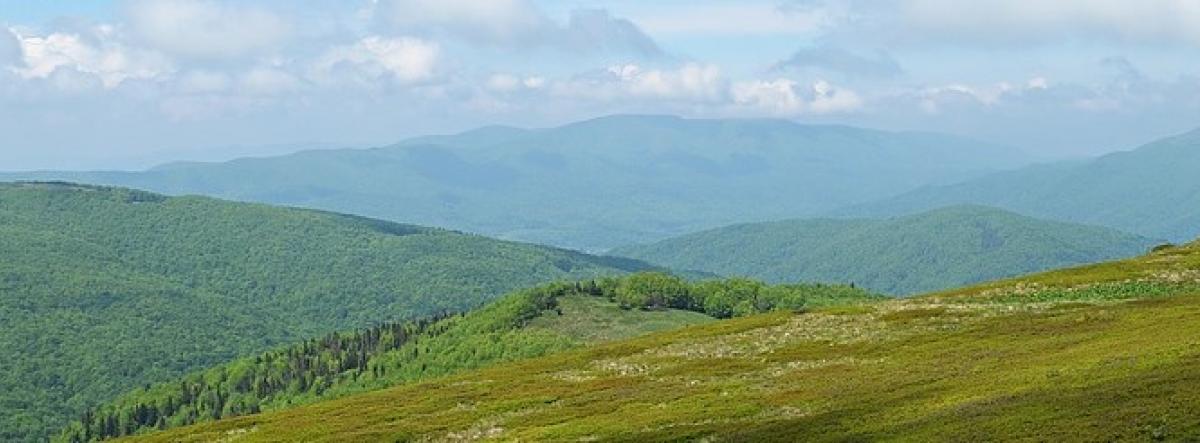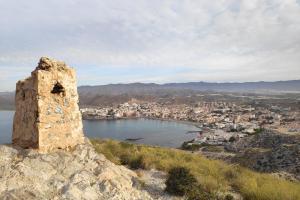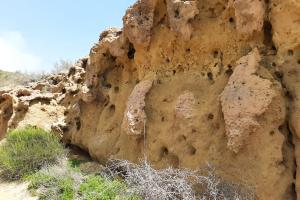Five stages of GR 92, along the costa cálida , "the warm coast", Murcia region
GR 92 is the (very) long-distance hiking trail along Spain's Mediterranean east coast. From Portou near the Spanish French border to Tarifa, near Gibraltar. Still, some 1,500 kilometres.( about 950 miles)
Walking from north to south, this coastal region offers on your left unprotected beaches with wild sea, narrow coves, rugged cliffs, palm trees and calm waters in the bays. On your right, panoramas of Murcia's mountains.
Nature lovers won't soon get bored here.
How to get there
A flight to Alicante. Where we hired a car for the remainder of the trip, among other things, to the first accommodation. On this trip, we were in the luxurious position of having two cars in spots. The one rented at Alicante airport and the car of the team member who recently had a flat on the Spanish east coast. That made it possible, if necessary, to shorten the day's stage a bit and put the luggage in the boot. Instead of on the back.
We were unable to find any information about luggage transport options locally. You could ask after each overnight stay in the hotel or flat.
Accommodation
Hotels or tourist flats along the way. As we walked at Easter, we booked all overnight stays early.
Altitude guide
As with many other coastal walks, this one does have considerable ascents and descents. Up to 340m (day 1).
Much of the route we walked goes through the protected coastal area between Bolnuevo and Aquilas.
On trail
Day 1: Bateria de Castillitos - Isla Plana.......................16 km
Day 2: Isla Plana - Bolnuevo...........................................15 km
Day 3: Bolnuevo - Puntas de Calnegre........................ 16 km
Overnight stay in Urbanizon Los Collados
Day 4: Puntgas de Calnegre - Miramar Galabardina..18 km
Day 5: Galabardina - Punta Parda.................................18 km
Overnight stay in Aquilas
Along the way
If you are in Spain during the week before Easter, Holy Week or Semana Santa, after a walking day, try to go and see one of the many processions that are also held in this region. As in Cartagena.
The start of our hike was at a 1933 defensive structure built during the dictatorship (coup in 1923) of Captain-General Primo de Rivera. At 250m altitude and with a fantastic view of the Mediterranean and the bay. Built in Disney-style, the castle served mainly as housing for a pair of hefty Vickers guns. To defend Cartagena's naval base in particular.
On to the "crossing" of the Sierra de la Muela. A protected nature reserve with a wide variety of plants. Typical Mediterranean forests with pine trees, rosemary and thyme colonies, esparto grasses and other survivors of a dry Mediterranean climate.
Sometimes it is difficult climbing and descending the paths, in the heat. But some of the views of the azure sea make up for a lot. Or the colourful, sometimes bizarre rock formations in the bays. Be sure to take plenty of provisions and drinks when "crossing". There is nothing for sale here on the way.
At the end of day 1, we can already see the destination: Isla Plana.
After the wilderness follows a stage right along the coast, say over the beach ( if you like) and opportunities abound to alternate walking with a dip in the sea (if you like). Palm trees complete the atmosphere; you're in the south! And after 15 kilometres in Bolnuevo. Admire the "natural monuments of Bolnuevo" for a while, Bizarre, windswept, petrified sand formations, at the beach.
The stage to Puntas de Calnegre begins again with ascents and descents through the now familiar landscape of the Mediterranean. With spots where you think: why walk any further?
On to the Torre de Cope del santo Cristo, a historical landmark on the coast. An observation tower erected in connection with the frequent attacks by Islamic North African pirates and Barbary pirates on fishermen and shepherds in this area.
Stay overnight in Galabardina, 1.5 kilometres west, off the coast. There is nothing else in Cabo Cope. By the way: you have now arrived in the province of Almeria ("Mirror of the Sea").
On the way to our terminus in Punta Parda, you pass through the town of Águilas. An originally Roman fishing port. On the headland, above the old town, stands the castle-fortress of San Juan de Águilas, built in 1579. The flat stage gives you plenty of time to visit the town of Aguilas.( Thanks to the Brexit, the number of English tourists here is decreasing sharply, they say).












